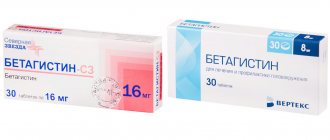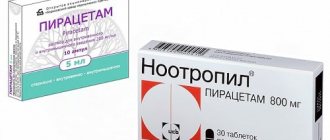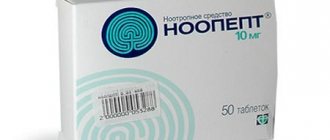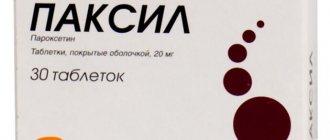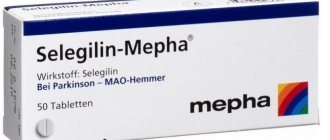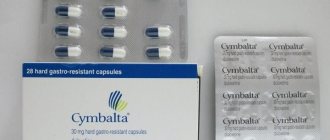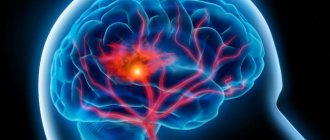Sirdalud or Mydocalm differences and which is better to choose
Treatment of diseases of the musculoskeletal system always involves an integrated approach. This includes massage, physiotherapeutic procedures and, of course, medication.
Drug therapy is a central aspect of the treatment of joint pathologies. Its main purpose is to relieve muscle spasm around the affected joint and eliminate pain. Only special drugs can do this: muscle relaxants. The most popular among them are Sirdalud and Mydocalm. But which one is better and why?
Sirdalud: description of the drug
The described drug belongs to the group of muscle relaxants that affect the central nervous system. The medicine has a single form - tablets.
The drug works on the basis of tizanidine.
Compound
The main active ingredient is tizanidine (4.576 mg). Also, each tablet contains excipients to ensure better absorption: colloidal silicon dioxide, microcrystalline cellulose, stearic acid, lactose.
The drug is available in the form of white or yellowish tablets with a beveled edge. They are packed in foil blisters. Each blister contains 10 single doses of medication. In total, the pack contains 3 blisters, that is, 30 tablets.
Indications and contraindications
Sirdalud has a fairly extensive list of indications for use, which includes:
- Myelopathy.
- Degenerative pathologies of the brain.
- Multiple sclerosis.
- Cerebral paralysis.
- Disturbances in cerebral circulation.
But we should separately note the effective effect of the drug on diseases of the musculoskeletal system. Sirdalud successfully fights functional diseases of the spine, and is also often used as a medicinal measure for postoperative rehabilitation. For example, after removal of a spinal hernia.
This remedy should not be used for pathologies of the kidneys and liver, or if you are intolerant to tizanidine.
Properties and Application
As a centrally acting muscle relaxant, Sirdalud directly affects the spinal cord. Acting on special alpha receptors, the main active substance suppresses the transmission of excitation through nerve channels. If there is increased muscle tone, it decreases. This allows the drug to be used not only as an antispasmodic, but also as an anesthetic.
The tablets are taken strictly orally. They can be divided into two parts. The drug is taken 3 times a day, either 2 mg or 4 mg. The specific dosage can only be determined by the attending physician, based on the individual physiological parameters of the patient. In some cases, another dose is added, but only before bedtime, since Sirdalud causes drowsiness.
Mydocalm: description of the drug
This medication is also a representative of muscle relaxants. It effectively treats muscle spasms and contractures resulting from diseases of the musculoskeletal system.
The main component of Mydocalm is Tolperisone hydrochloride.
What is the difference
Both Sirdalud and Mydocalm are muscle relaxants. Their action is aimed at eliminating excessive muscle tone. However, they carry out their therapeutic function on the basis of different substances: Tizanidine and Tolperisone.
Sirdalud has quite serious side effects and contraindications. It causes severe drowsiness, so taking it while driving is prohibited.
The undoubted advantage of Sirdalud is its action as an analgesic. It is also absorbed into the blood faster than Mydocalm and activates its effect within an hour.
Which drug is best suited for whom?
Despite the fact that both drugs have proven their effectiveness, Mydocalm has much fewer contraindications and side effects. It is widely used to treat children, as well as women during pregnancy. Of course, its use must be agreed with the attending physician.
Mydocalm has a wider range of indications. It is also better suited for people who have problems with the gastrointestinal tract. In addition, it is acceptable for drivers to take it, since it does not cause drowsiness.
Indications for use
Vertebral, joint, and headaches caused by cervical osteochondrosis and not only can occur in people of different genders and ages. For their treatment, today the pharmaceutical industry offers a large number of different drugs, including Mydocalm. What Mydocalm tablets are, instructions for use, prices, analogue drugs and reviews are described below. Mydocalm is indicated for the treatment of arthrosis, osteochondrosis of the lumbar, cervical, and other joint syndromes that can occur not only in adults. But also in children. It can also be prescribed during pregnancy, but very carefully and always under the strict supervision of the attending physician.
It is a centrally acting muscle relaxant. Its active substance is tolperisone hydrochloride. The drug is well absorbed from the gastrointestinal tract and excreted by the kidneys. The main indications for the use of Mydocalm tablets and injections are:
- spasms and increased tone of striated muscles, which can occur due to diseases of the central nervous system
- spasms and increased muscle tone; rehabilitation treatment after traumatological and orthopedic operations
- non-inflammatory diseases of the brain
- pain syndrome caused by hemorrhoids
- as one of the drugs in the combined treatment of vascular diseases: obliterating endarteritis, Raynaud's syndrome, diabetic angiopathy, etc.
Mydocalm is also used by gynecologists. It can be prescribed for severe menstrual pain, as well as for high risks of spontaneous abortion, which can occur due to increased uterine tone. It is also prescribed to people who have had a stroke to treat symptomatic muscle spasms.
Side effects
This product is available in the form of tablets and infusion solution. Its active ingredient is tolperisone hydrochloride. The list of components of the drug in soluble format includes lidocaine.
The principle of action of Mydocalm is that its active ingredient inhibits the conduction of nerve impulses, suppressing spinal reflexes. The drug reduces muscle tone. Tolperisone hydrochloride prevents the penetration of sodium and calcium into nerve cells.
The medicine is indicated for:
- increased muscle tone;
- muscle spasms occurring against the background of myelopathy, stroke, arthrosis or multiple sclerosis;
- recovery after operations on the musculoskeletal system;
- pain syndrome caused by injuries;
- diffuse scleroderma;
- Raynaud's syndrome;
- thromboangiitis;
- cerebral encephalopathy, which is accompanied by muscular dystonia.
The drug has restrictions on its use. Among them:
- epilepsy;
- myasthenia gravis;
- age less than 3 years;
- allergy to substances contained in the medication.
When taking Mydocalm, the following negative reactions may occur:
- pronounced decrease in blood pressure;
- feeling of drowsiness and weakness;
- headache;
- Digestive problems.
When taking Mydocalm, negative reactions such as a pronounced decrease in blood pressure may occur.
Mydocalm may cause side effects:
- headache;
- weakness;
- hypotension;
- nausea;
- vomit;
- skin rashes;
- itching;
- bronchospasm;
- anaphylactic shock.
Sirdalud can cause the following adverse reactions:
- bradycardia;
- dry mouth;
- hypotension;
- nausea;
- vomit;
- hepatitis;
- muscle weakness;
- fatigue;
- insomnia;
- dizziness.
When prescribing increased dosages of the drug (to relieve severe spasms), side effects may occur more often, but this is not a reason to discontinue the drug.
Contraindications
- Severe renal and hepatic dysfunction.
- Overreaction to tizanidine.
- Combination of tizanidine with fluvoxamine.
What does Mydocalm help with?
The indication for the use of a potent muscle relaxant is pathologically increased muscle tone, which occurs in diseases of the central nervous system and provokes pain. A neurologist may prescribe Mydocalm in the following cases:
- in the treatment of osteochondrosis to eliminate severe pain;
- to relieve attacks of severe pain that occur against the background of vascular innervation disorders;
- in the combined treatment of osteochondrosis, arteriosclerosis, diffuse scleroderma;
- for relieving muscle spasms during postoperative rehabilitation therapy;
- for the treatment of non-inflammatory brain diseases that are accompanied by muscular dystonia;
- as a therapy for increased muscle tone that occurs due to pathologies of the musculoskeletal system;
- for ischemic stroke to relieve spasms of cerebral vessels.
Mydocalm should be taken in strict accordance with the instructions and recommendations of the attending physician. There have been no targeted studies of the effect of a muscle relaxant on concentration and the ability to operate machinery and vehicles. Reviews from patients indicate that during the entire practice of using the tablets, no hypnotic effect or decrease in reaction rate was observed after taking it.
How to take Sirdalud for osteochondrosis
Both drugs are centrally acting muscle relaxants and have the same effect on the body. They can be prescribed simultaneously, but this must be done by the attending physician.
Sirdalud tablets are taken after meals. The dosage is prescribed by the doctor: 2-4 mg 3 times a day. If necessary, increase the dose. The maximum daily dose is 36 mg.
The drugs have similar effects and the same level of effectiveness. However, Sirdalud lasts longer, because its active component spends more time in the blood plasma.
Sirdalud is a medicinal drug characterized by a muscle relaxant effect. This medicine is often used to treat osteochondrosis. Sirdalud does not depress the functioning of the central and autonomic nervous systems.
How many days can I take injections?
The dosage of mydocalm and the scheme of its use are determined by the attending physician depending on the patient’s age, type, severity and course of the disease. Standard daily doses of mydocalm for adults are:
- When taken orally, 150-450 mg (in 3 divided doses). The drug is taken with meals.
- For intramuscular administration - 200 mg (in 2 doses).
- For intravenous administration - 100 mg (one-time). IV administration must be carried out using the drip method.
For children, the daily dose of mydocalm is determined at the following rate: Age up to 6 years - 5-10 mg/kg/s (3 times a day, orally). If necessary, the tablet can be crushed before taking. Ages from 7 to 14 years - (3 times a day, orally). Many patients are interested in how many days Mydocalm should be injected in different cases. Most often, the drug is used in short courses, which are repeated as necessary during treatment with mydocalm. injections can be given for 3 to 7 days. The maximum period for their use is 2 weeks. In severe conditions, Mydocalm injections are allowed for up to a month. but more often, for such a long period, the drug is prescribed in tablet form.
Only a doctor can decide how long the course of treatment will last. at the first signs of improvement in well-being and a decrease in the intensity of its symptoms, other medications are prescribed.
How to use
The dosage of Mydocalm for osteochondrosis is selected individually. If you refer to the instructions, you can find out that the tablets should be taken three times a day, and the amount of medication for a single dose will vary from 50 to 150 mg.
The abstract also describes the method of using injections. Depending on the location of placement, the frequency of administration varies. The manufacturer indicates that in each case, the daily dose of the medicine and the duration of its use should be established by the doctor, based on the severity of the disease.
Pills
You need to take Mydocalm tablets for osteochondrosis 3 times a day. The initial dose of the drug is 50 mg. With normal tolerability of the drug, for more effective treatment of osteochondrosis, the single volume is gradually increased.
For osteochondrosis, as for other indications for use, Mydocalm is taken after meals. The dragee is swallowed whole and washed down with clean water. If the patient is unable to swallow the pill whole, then it is permissible to crush it first.
The powdered tablet should also be taken with a sufficient amount of water. The noticeable effect of the medication begins 40 minutes after administration.
Injections
In case of severe osteochondrosis, it is recommended to use injections. The same form of the drug is prescribed to patients undergoing treatment in a hospital. When using Mydocalm by injection, the symptoms of osteochondrosis are eliminated faster, which makes it possible to use it in emergency situations, for example, during an attack.
For adult patients, the dosage of the drug usually remains standard. Osteochondrosis of any part of the spine involves intramuscular injection of 1 ml of solution, which is the volume of one ampoule. The frequency of injections is twice a day.
In case of severe condition of the patient or osteochondrosis complicated by brain hypoxia, intravenous administration is recommended. In this case, a portion of the medicine is administered once a day slowly or through a dropper. The volume of Mydocalm for intravenous use in osteochondrosis is 1 ml.
For hernia of the lumbar spine
Treatment of intervertebral hernia is carried out using medicinal and surgical methods. If the patient’s condition is not advanced, and treatment can be carried out without surgery, then the patient is prescribed a course of several medications, among which Mydocalm is often present.
The use of medication in the treatment of a hernia is indicated to eliminate excessive tension in the muscles of the lumbar region, since hypertonicity is the culprit of stiffness of movement, discomfort or pain. In acute conditions, it is recommended to use Mydocalm injections, since it contains lidocaine. In this case, a stronger analgesic effect will be achieved.
In each case, an individual regimen of use is developed, which must take into account the characteristics of the patient and other drugs taken in parallel.
On average, it is recommended to give the patient intramuscular injections at the beginning of the course. To eliminate spasticity and relieve compression of the receptors, treatment with injections is recommended for 3 days. Injections are given in the morning and evening; the average dosage is 1 ml. After the exacerbation is relieved, the doctor may consider it necessary to use the tablet form. The dosage and duration of use will be determined by the condition of the body and its response to treatment. In addition, Mydocalm tablets can be prescribed to prevent exacerbation of pathology.
About osteochondrosis
The doctor tells each patient individually how to take Mydocalm for osteochondrosis. There is no generally accepted standard treatment regimen for this drug.
When prescribing the drug, it is necessary to take into account the individual characteristics of the patient: the severity and duration of the disease, symptoms, age, the possibility of pregnancy in women and body weight for children.
Osteochondrosis is a complex of dystrophic changes in joints and cartilage. Pathologists distinguish between cervical, lumbar, thoracic and intervertebral localization. The last type is less common than the others, but at the same time it becomes the most serious.
Therapy for osteochondrosis includes a set of measures that includes drug correction.
Reception features
Pregnancy in the 1st-3rd trimesters is a reason to limit use, and not completely discontinue this drug. The drug is prescribed exclusively on the recommendation of a specialist. The ratio of actual benefit and harm to the fetus and the maternal body is taken into account.
Tizaluda tablets are prescribed to adults, two units (2 or 4 mg) three times a day. In case of complications, another appointment is added in the late afternoon. The medicine is washed down with clean water, you can use juice or tea. An exception is dairy and fermented milk products, especially for patients suffering from hypersensitivity to lactose and related diseases.
According to the instructions for use, the maximum concentration of the active substance should not exceed 36 mg per day. People suffering from kidney failure are prescribed 2 mg of the drug once a day.
Can pregnant women take the drug Tizalud? The instructions state that clinical studies have not been conducted on this group of patients, so there is no information about the possible risk to the fetus. Pregnancy is a contraindication, although in particularly severe cases the doctor may decide to start therapy.
Tizanidine is excreted in small quantities into breast milk. If there is a need for treatment during lactation, then breastfeeding will have to be stopped for a while.
This medicine can be taken both before and after meals. The tablets should be taken with plenty of water. The daily dose on the first day of taking Tizalud should not be more than 6 mg. This amount should be evenly divided into 3 doses. Over time, the dose of the drug can be increased by 1–3 mg. The interval between dosage increases should be from 4 days to 1 week.
For people suffering from renal failure, the initial dose of the drug is no more than 2 mg per day. Increasing the dose should be done with extreme caution. If therapy is tolerated normally, the frequency of use can be increased.
The duration of taking Tizalud depends on the severity of muscle spasms and pain. For acute muscular-tonic pain, the treatment course can last from 1 week to 1 month. For chronic pathologies of this nature, the duration of therapy can range from 1 month to a year.
When to take the drug for the treatment of osteochondrosis
One of the indications for the use of Mydocalm is osteochondrosis. Doctors everywhere prescribe this medication for patients with its symptoms. At the same time, a person has doubts about the effectiveness of using Mydocalm, because there are different types of diseases, but the same drug is always recommended.
To dispel your doubts and understand that if any parts of the spine are affected, you can take medicine, you need to know the principle of its action.
The medicine has the following properties:
- antispasmodic (relaxes muscle tissue during spasm);
- anesthetic (does not act directly on pain, but eliminates it through relaxation);
- vasodilator (normalizes blood flow);
- sedative (has a calming effect);
- lymphatic drainage (eliminates stagnation in lymphoid tissue).
With all this, Mydocalm does not affect the functioning of the central nervous system, does not inhibit the speed of impulses and does not cause drowsiness. The use of the medication is recommended for all patients who have pain in the spine of any location.
In the treatment of spinal osteochondrosis with Mydocalm, the effect is achieved by influencing the smooth muscles of the skeleton. The medication relaxes pathologically contracting tissue and restores its original state. Due to this, blood flow is normalized, pinching of roots, nerve endings and blood vessels is eliminated.
Are there any complications? Information about adverse reactions
Can taking Tizalud tablets be dangerous? Instructions for use contain information about the possible development of adverse reactions.
- Occasionally, patients are diagnosed with disorders of the nervous system, which are accompanied by insomnia and other sleep disorders, as well as periodic dizziness. It is extremely rare that therapy is associated with hallucinations and mental disorders.
- The drug may affect the functioning of the cardiovascular system. During treatment, bradycardia may develop, as well as a sharp decrease in blood pressure (sometimes to the point of collapse).
- Adverse reactions from the digestive tract may occur. Some patients complain of dry mouth, nausea, and dyspepsia.
- Other possible complications include the appearance of muscle weakness and increased fatigue.
- Sometimes sudden withdrawal of the drug can be dangerous, especially after long-term therapy. In such cases, a strong increase in blood pressure and the development of tachycardia are possible. Cerebrovascular accident is extremely rare.
Sirdalud
The medicine comes in the form of tablets containing 2 or 4 mg of tizanidine. The manufacturer of the drug is Novartis Pharma AG, Switzerland.
10 tablets are placed in a blister. One cardboard pack contains 3 blister packs.
Tizanidine is a muscle relaxant that affects the central nervous system. The substance stimulates receptors in the spinal cord, inhibiting the production of an amino acid that activates NMDA receptors. This action leads to the relief of muscle hypertonicity.
Tizanidine has a moderate analgesic effect. The tablets quickly eliminate muscle spasms, eliminate cramps, increasing motor capabilities.
Indications:
- Skeletal muscle spasms caused by neurological disorders
- Postoperative period after orthopedic surgeries and injuries
- Static and functional pathologies of the spinal column.
Sirdalud is contraindicated in case of intolerance to tizanidine, liver dysfunction, during breastfeeding, in childhood and pregnancy.
The recommended daily dose of Sirdalud is 6 ml, divided into 3 doses. On days 3-7 of therapy, the amount of the drug increases by 2-4 mg. The maximum daily dosage is 36 mg.
Negative effects of Sirdalud:
- Liver – hepatitis, increased concentration of transaminases
- Musculoskeletal system – myalgia
- Gastrointestinal tract - xerostomia, nausea, stool upset.
Other possible negative reactions are malaise, hypotension, vertigo, drowsiness, bradycardia, hallucinations.
If the dose is exceeded (from 400 mg), symptoms such as coma, nausea, drowsiness, hypotension, respiratory dysfunction, vomiting, miosis, anxiety, and vertigo may develop. Therapy consists of repeated administration of enterosorbents. Forced diuresis is also effective.
Use in children under 12 years of age
- spasticity of skeletal muscles in neurological diseases (for example, multiple sclerosis, chronic myelopathy, degenerative diseases of the spinal cord, consequences of cerebrovascular accidents and cerebral palsy / patients over 18 years old/).
- severe liver dysfunction;
- simultaneous use with strong inhibitors of CYP1A2 isoenzymes (including fluvoxamine or ciprofloxacin);
- hypersensitivity to tizanidine or any other component of the drug.
The use of Sirdalud MR in children is not recommended, because Experience with the drug in children is limited.
Since there are no controlled studies of tizanidine in pregnant women, it should not be used during pregnancy unless the potential benefit outweighs the potential risk.
Tizanidine is excreted in breast milk in small quantities. However, women who are breastfeeding children should not use the drug.
Contraindicated in cases of severe liver dysfunction.
Sirdalud® MR should be used with caution in patients with renal failure.
Caution should be exercised when using Sirdalud MR in elderly patients. Experience with the use of Sirdalud MR in elderly patients is limited. Based on pharmacokinetic data, it can be assumed that in some cases renal clearance in these patients may be significantly reduced.
Spastic condition of skeletal muscles caused by neurological diseases (multiple sclerosis, chronic myelopathy, stroke, degenerative diseases of the spinal cord). Painful spasm of skeletal muscles caused by damage to the spine (cervical and lumbar syndromes) or occurring after surgery (for a herniated disc or osteoarthritis of the hip).
Dosage regimens:
- For mild pain, Sirdalud is prescribed 2–4 mg at night until the pain is relieved. Regular course: 5–7 days.
- For moderate cases, start with 2–4 mg at night, gradually increasing the dose to 6–8 mg/day.
- In severe cases, add 2-4 mg at night. Improvement is noted on the 3rd day of administration.
- For chronic pain, course of treatment: 2–4 weeks.
How much does it cost and what can replace the original drug “Sirdalud”? Price, analogues are offered to your attention:
THE CHIEF CHINESE JOINT DOCTOR GAVE INVALUABLE ADVICE:
ATTENTION! If you do not have the opportunity to get an appointment with a GOOD doctor, DO NOT SELF-medicate! Listen to what the rector of the Chinese Medical University, Professor Park, says about this . And here is the invaluable advice on restoring diseased joints that Professor Park gave:
Read in full >>>
- "Tizanidine";
- "Tizanil";
- "Tizalud";
- "Sirdalud MR".
The price directly depends on the dose and ranges from 225 to 550 rubles for 30 tablets. The cost of “Sirdaluda MR” (30 capsules of 6 mg) averages 545 rubles.
Tizanidine tablets are taken orally with water. Start using the drug with a single dose at night of a minimum dose of 2 mg. For pain and muscle spasms, the dose is gradually increased to 3 times a day, 2–4 mg per dose, and if there is no effect, the drug is additionally taken at night. For neurological diseases with a tendency to spasms of skeletal muscles, the dosage is selected individually.
At the beginning of treatment, it should not exceed 6 mg in 3 doses. If necessary, increase the dose once every 3–7 days by 2–4 mg. The optimal result is achieved when taking 12–24 mg/day, 3–4 times a day. The highest dosage is 36 mg/day.
"Sirdalud MR" (6 mg/capsule) is also taken orally, maximum 1 capsule 2 times a day. Occasionally, if necessary, use 24 mg/day - 1 capsule 3-4 times a day.
The drug can be used:
- with spasticity of skeletal muscles;
- herniated intervertebral discs;
- muscle spasms with pain in various diseases of the spine.
Tizanidine is effective for the following indications:
THE CHIEF CHINESE JOINT DOCTOR GAVE INVALUABLE ADVICE:
ATTENTION! If you do not have the opportunity to get an appointment with a GOOD doctor, DO NOT SELF-medicate! Listen to what the rector of the Chinese Medical University, Professor Park, says about this . And here is the invaluable advice on restoring diseased joints that Professor Park gave:
Read in full >>>
- damage to the cervical roots;
- spondylopathies;
- spinal cord diseases;
- cervicobrachial and cervicocranial syndromes;
- diseases of the sacrolumbar region;
- muscle hypertonicity;
- cerebral palsy;
- multiple sclerosis;
- arthrosis;
- lesions of the intervertebral disc;
- consequences of cerebrovascular diseases.
The drug is prescribed depending on the case of the disease. The instructions for the medication imply taking the drug only as prescribed by a specialist.
Instructions for use (method and dosage) for joints:
- Neurological pathology leading to spasm of skeletal muscles. The initial dosage is a 2 mg tablet three times every 24 hours. After a couple of days, the dosage is increased to 3-6 mg. The dose is selected depending on the severity of the symptoms and the body’s reactions to the medication. The best dosage per day is 12-24 mg. If the medicine is taken over 36 mg per day, then side effects are possible.
- For older people. In this case, the dosage is adjusted. Monitoring by medical professionals is required if the drug is prescribed. Often, the dose of tablets is reduced, because in older people renal clearance is slowed down, that is, the rate of renal excretion is several times lower than in young people. If you use a large dosage, this may cause the accumulation of metabolites in the blood.
- In case of renal failure. The drug is taken only containing 2 mg of the active substance 3 times a day. In accordance with changes in the clinical picture and depending on the stability of the components, the dosage is adjusted.
Tablets are prescribed orally with liquid. The initial dosage should be exactly 2 mg three times a day so that the body adapts to the components of the drug, this will help avoid side effects.
Tablets with a dosage of 2 and 4 mg can be divided into 2 parts. Special treatment is also needed for severe liver dysfunction. Most often, the specialist refuses to prescribe, since Sirdalud instructions allow the use of the medicine only in cases of moderately severe organ dysfunction.
The use of the medication begins with the lowest dose, then the dosage is increased until it reaches the optimal ratio of treatment effectiveness and drug tolerability.
Where else is it used?
The medicine is widely used for other ailments.
So, for the drug Sirdalud, the instructions for use indicate that you can take the medication in the following cases:
- after a stroke to neutralize convulsive manifestations of muscles;
- for spinal cord injury and traumatic brain injury;
- to eliminate muscle pain;
- for back pain (radiculopathy), neck pain, headache;
- if necessary, get rid of symptoms caused by excessive stress on the skeleton and muscles;
- after injuries, spinal surgeries, etc.
Overdose
Cases of drug overdose have been identified.
In this case, the following symptoms of an excess of medicine in the body appear:
- Excessively low blood pressure.
- Vomiting and nausea.
- Drowsiness, dizziness.
- Irritable state.
- Labored breathing.
- Coma (only in severe cases).
After taking too high a dose of the drug, you need to rinse the stomach for 60 minutes and take sorbents. In addition, forced diuresis is necessary, which is able to cope with excess drug and remove it from the body. Next, symptomatic treatment is performed.
THE CHIEF CHINESE JOINT DOCTOR GAVE INVALUABLE ADVICE:
ATTENTION! If you do not have the opportunity to get an appointment with a GOOD doctor, DO NOT SELF-medicate! Listen to what the rector of the Chinese Medical University, Professor Park, says about this . And here is the invaluable advice on restoring diseased joints that Professor Park gave:
Read in full >>>
You should not abuse smoking, alcohol, sleeping pills and sedatives while taking the drug. If these recommendations are ignored, side effects that threaten the person with death are possible.
For what diseases is the drug “Sirdalud” recommended? Indications for use and analogues will be discussed further. This medication is prescribed for the following disorders:
- Poor blood circulation in the brain.
- Cerebral paralysis.
- Degenerative disorders of the spinal cord.
- Multiple sclerosis.
- Myelopathy.
Also, for some other symptomatic diseases, the attending physician prescribes the medication “Sirdalud”. Indications for the use of this drug are as follows:
- Diseases of the spine (spinal column), such as osteochondrosis, radiculitis, etc.
- Rehabilitation after surgery, that is, restoration of the human body after surgery, for example, after removal of an intervertebral hernia or osteoarthritis of the hip.
The dosage regimen of the therapeutic agent is determined strictly individually by the attending physician. The recommended initial dose of Sirdalud is 2 mg three times a day. The drug is prescribed for oral administration. In case of increased pain in muscle spasms, it is recommended to take 2-4 mg of the drug “Sirdalud” 3 times a day (the instructions for use do not describe analogues of this drug, but we will definitely talk about them below).
To relieve muscle spasms caused by neurological disorders, at the initial stage of treatment, no more than 6 mg of the drug per day is recommended. The optimal therapeutic dose per 24 hours is from 12 to 24 mg.
"Sirdalud MR" is a capsule with a dosage of the active substance of 6 mg. The initial dose is 1 capsule per day. Gradually you can double it. The optimal dose for most patients is 2 capsules, or 12 mg. In exceptional cases, the dose per day is increased to 4 capsules or 24 mg. The duration of the course of treatment is individual and is selected by the doctor depending on the patient’s health condition.
THE CHIEF CHINESE JOINT DOCTOR GAVE INVALUABLE ADVICE:
ATTENTION! If you do not have the opportunity to get an appointment with a GOOD doctor, DO NOT SELF-medicate! Listen to what the rector of the Chinese Medical University, Professor Park, says about this . And here is the invaluable advice on restoring diseased joints that Professor Park gave:
Read in full >>>
This therapeutic drug is prescribed with caution to patients over 65 years of age. What other contraindications does Sirdalud (tablets) have? Analogues of the drug and the original drug should not be taken in the presence of the following conditions:
- Intolerance to tizanidine or any other component of this medication.
- Congenital lactase deficiency.
- Pregnancy.
- Breastfeeding a baby.
- Liver and kidney diseases (liver and kidney failure).
In addition, there are restrictions regarding interactions with other medications. The list is specified in the instructions for use of the drug "Sirdalud". The instructions (reviews only confirm this) are written in quite accessible language. Therefore, be sure to read it before taking any medicine prescribed by your doctor.
Sirdalud or Mydocalm comparison of drugs and which is better
Sudden back pain, making it impossible to move fully, is familiar not only to people of the older generation. Unfortunately, in recent years, young people are increasingly faced with this.
People 30-35 years old, or even younger, complain of severe pain in various parts of the spine.
This is due to the lifestyle of modern man: insufficient physical activity, poor nutrition, and numerous stresses.
The main cause of a painful attack in this case is excessive tension in the muscles that support the spine.
Therefore, the primary task in providing assistance is to take medications that can relax muscle cells. Bringing muscle tone back to normal not only eliminates the sensation of pain.
In addition, blood circulation at the site of pathology improves. And this, in turn, contributes to the resorption of inflammation processes at the site of the disease.
Today on the shelves of our pharmacies you can find a wide range of drugs that eliminate excessive muscle tension. Most often they buy sirdalud and mydocalm in pharmacies. Let's try to figure out what is better to use and in what case?
Mydocalm
The main component is tolperisone. At the pharmacy you can buy the medicine in the form of:
- Tablets of 50 mg and 100 mg, which are drunk 2-3 times during the day.
- Solution for injection into muscle and vein. The drug is injected into the muscle 2 times a day, and into a vein – 1 time per day.
The list of diseases for which mydocalm can be used is very long:
- Diseases of the nervous system in which the muscles are overly tense.
- Joint diseases.
- Treatment after surgery on the musculoskeletal system.
- Diseases that are caused by severe constriction of blood vessels.
- Infantile cerebral palsy.
Expectant mothers who are in an “interesting situation” and who are breastfeeding are prohibited from taking Mydocalm. No studies have been conducted on them, so there is no need to take risks in this case.
The following side effects may occur:
- Weakness in the body.
- Headache.
- Blood pressure may drop below normal.
- Discomfort in the abdomen (nausea, vomiting).
Comparison of drugs
Both drugs belong to the same group - centrally acting muscle relaxants.
A very important circumstance is that mydocalm is approved for use in children. Sirdalud is prohibited for use by persons under 18 years of age.
Often people have to be treated with several drugs at once. It must be taken into account that sirdalud cannot be used with fluvoxamine and ciprofloxacin.
And mydocalm has a great positive effect when taken together with anti-inflammatory drugs. The latter begin to act more powerfully. Therefore, you can reduce their dose.
This can be considered an advantage of the medicine, since reducing the dosage of anti-inflammatory drugs also reduces the undesirable consequences of their use.
Both drugs are manufactured by foreign manufacturers. Sirdalud is produced in Switzerland, and Mydocalm is produced in Hungary.
For many, the price of the drug is of great importance. So, on average, sirdalud costs 150-190 rubles, and mydocalm – 350-420 rubles.
What and when is best
During periods of acute severe pain, in which every unnecessary movement causes incredible agony, it is better to use the drug Mydocalm. It is available not only in tablets, but also in a solution that can be injected into a muscle or into a vein. The medicine that enters the body using these methods will begin to act faster. Accordingly, a person is more likely to feel relief.
If it is necessary to use centrally acting antispasmodics in children, you can use only mydocalm, since it is approved for use in children from 3 years of age.
If back pain occurs in women expecting a baby or nursing mothers, it is possible to inject mydocalm into a muscle or into a vein. But at the same time, you need to think carefully about the benefits for the mother and unwanted health problems that may arise in the baby. Research on them is usually not conducted, so no one can say with confidence that the medicine is completely safe.
In all other situations, you can purchase sirdalud. Its price is lower, but its therapeutic effect is the same.
Treatment options
Pathology of the musculoskeletal system ranks 3rd in the world among the causes of temporary disability. According to WHO, more than 4% of the world's population suffers from various diseases of the spine and joints. In this group, pathologies that cause back pain occupy a significant place. Their frequent causes are spondylopathies and spondylosis.
Therapeutic measures are aimed at reducing or eliminating pain associated with the following types of inflammation:
- with aseptic, which occurs when the structure of the spine is damaged;
- with autoimmune.
What therapy is used?
- The most justified is the prescription of non-steroidal anti-inflammatory drugs as the main therapeutic agent.
- In case of pain, protective muscle tension is formed, which makes it necessary to use muscle relaxants.
An effective medicine is tizanidine, represented by both the original drug and products containing it, among them the Russian-made analogue of Sirdalud - Tizalud, which compares favorably in price.
What effect does the main medicinal substance have?
- A centrally acting muscle relaxant, tizanidine, causes muscle relaxation.
- It has analgesic properties, preventing the transmission of pain impulses.
- The original and any analogue inhibit the production of stomach acid and prevent mucosal damage associated with anti-inflammatory drugs.
Along with the treatment of dorsopathy, the original drug "Tizanidine" (analogue of "Sirdalud") is used in the treatment of the following diseases:
THE CHIEF CHINESE JOINT DOCTOR GAVE INVALUABLE ADVICE:
ATTENTION! If you do not have the opportunity to get an appointment with a GOOD doctor, DO NOT SELF-medicate! Listen to what the rector of the Chinese Medical University, Professor Park, says about this . And here is the invaluable advice on restoring diseased joints that Professor Park gave:
Read in full >>>
- myofascial syndrome;
- osteoporosis (to reduce secondary muscle tone in compression fractures);
- spastic conditions in neurological diseases.
To relieve spastic pain with the drug "Sirdalud" (instructions, analogues - their list - are available in the attachment), it is recommended to take 2 mg of the drug 3 times a day. However, based on practical experience, it is advisable to start taking tizanidine with 2 mg before bedtime. On days 3–4, the dose can be increased by 2 mg.
Muscle relaxants are added to treatment if there is no effect from NSAIDs (non-steroidal anti-inflammatory drugs). The original "Tizanidine" (like all analogues of "Sirdalud") is a centrally acting muscle relaxant. In addition to relaxing muscles, it has a slight analgesic effect.
There are many methods to treat neck pain. The advantage is a multi-component approach, represented by:
- manual therapy;
- physical activity;
- special exercises, which are the main element of combination therapy.
More information about the drug Mydocalm
Mydocalm is recommended for use in the following cases:
- muscle hypertonicity, spasms of striated muscles in diseases of the central nervous system (encephalomyelitis, stroke as a result of blockage of cerebral vessels, multiple sclerosis, myelopathy);
- muscle hypertonicity and spasms in diseases of the musculoskeletal system (arthrosis, spondylosis, lumbar syndrome, spondyloarthrosis);
- rehabilitation therapy after surgery (as a result of orthopedic disorders, injuries);
- diseases of the vascular system, namely obliterating atherosclerosis and thromboangiitis, diffuse scleroderma, Raynaud's disease;
- types of encephalopathy characterized by muscular dystonia.
The drug has few contraindications, but they are all quite serious. Mydocalm is not used for epilepsy and myasthenia. The drug is prohibited for use by children under 3 years of age. During pregnancy and lactation, Mydocalm is used only when the likely benefit outweighs the harm.
The dosage of the drug in tablets is determined by the age of the patient and can vary from 5 to 150 mg per day. The amount of solution for injection also changes, but depending on the method of administration. It can be administered intramuscularly at 100 mg per day (total 200 mg), and intravenously at 100 mg per day. Side effects are as follows:
- hypotension;
- general weakness;
- headache;
- disorders of the digestive tract (nausea, vomiting);
- Less common are allergic reactions, which are manifested by redness of the skin, rash, itching, urticaria, anaphylactic shock, bronchospasm.
However, some drugs enhance the effect of the active substance in Mydocalm on the body. These include psychotropic medications and drugs used for general anesthesia. This must be taken into account when calculating the dosage of Mydocalm. This drug can be taken at the same time as other medications.
Mydocalm and alcohol: compatibility and consequences
The abstract does not contraindicate the use of alcohol-containing drinks with the medicine. The medication is not a sedative; when interacting with alcohol, it does not cause consequences that pose a threat to health and life. There are no negative manifestations during injections. Treatment with tablets is contraindicated in case of serious kidney pathologies. The doctor may replace them with medication injections. Healthy kidneys are exposed to destructive effects. The simultaneous use of Mydocalm with alcoholic beverages increases the negative effects. The product in tablets, interacting with ethanol, can cause consequences that are difficult to predict.
When taking Mydocalm, it is better to limit or completely avoid drinking drinks containing alcohol.
Alcohol can enhance the effect of a medicine, thereby causing signs of an overdose, or, on the contrary, neutralize the properties of the medicine.
It is strictly contraindicated to combine alcohol with medication if it was prescribed after surgery. Under the influence of alcohol, the blood thins and then sharply thickens, which leads to thrombosis. Mydocalm tablets and alcohol, the compatibility of which is discussed in this article, is not the best combination for the human body. Scientists have proven the fact that drinking a small amount of alcoholic beverages will benefit the body, but drinking it in excess will only harm it. Therefore, imagine what will happen to your body if you use Mydocalm and alcohol at the same time (compatibility, consequences are described in this article).
Composition and properties of Sirdalud
These drugs are included in one pharmacological category - muscle relaxants. However, they have different compositions.
Medicines have not only different compositions, but also different dosages. This must be taken into account when replacing them with each other.
The daily dose of Sirdalud is determined individually. The maximum amount of muscle relaxant per day should be no more than 36 mg.
Pharmaceutical products also have some differences in contraindications. The drug Sirdalud has more of them. In addition, it has more side effects.
The drug Sirdalud does not contain lidocaine. Mydocalm can be used to treat children over 3 years of age, and its analogue can only be used in adult patients.
To choose a product that is suitable for its principle of action, you need to compare different options. They may differ in composition, but have a similar effect on the body. Sirdalud is a product containing the active component tizanidine. It differs in composition, but affects the body in a similar way as Mydocalm.
The active substance in the tablets is released evenly, which is an advantage of the drug. The main component tizanidine is absorbed mainly by the liver, where it is metabolized. The pharmacological activity of the metabolites has been tested and they are inactive.
The centrally acting muscle relaxant in question is indicated in a number of cases:
- muscle spasms caused by diseases of the spine (spondylosis, hemiplegia); Sirdalud is also prescribed for osteochondrosis, lumbar and cervical syndrome;
- restorative therapy after surgery if intervertebral hernias are being combated;
- spasms as a result of pathological conditions of a neuralgic nature (sciatica, epilepsy, multiple sclerosis, myelopathy, cerebral palsy, convulsions, cerebrovascular accidents).
The drug is permissible to take only if the benefits of therapy in this case are higher than the possible harm.
It is recommended to take the tablets after meals, since it has been proven that food does not affect the absorption of the drug. The dosage of Sirdalud is determined individually. In some cases, in case of severe pain, it is allowed to take an additional dose before bedtime.
The drug has quite a lot of side effects:
- bradycardia and hypotension;
- dry mouth often occurs, much less often gastrointestinal disturbances, which manifest themselves as nausea and vomiting;
- cases of hepatitis have been recorded;
- a common symptom is increased fatigue; muscle weakness is much less common;
- drowsiness or insomnia, dizziness may occur.
If laboratory testing is performed, elevated liver transaminases are often detected. There is a change in consciousness, hallucinations, and visual impairment. Such cases are rare, but occurred under the influence of the active substance of the drug.
Mydocalm and Sirdalud belong to the group of centrally acting muscle relaxants. They affect the movement of impulses in the central nervous system, and not the muscles. These medications have different active substances and indications for use. The active component of Sirdalud is tizanidine. The active component of Mydocalm is tolperisone. Both medications are made in tablet form.
Sirdalud imitates the effect of norepinephrine on adrenergic receptors. Stimulation of these receptors prevents the formation of the neurotransmitter, as a result of which impulse transmission is blocked. Sirdalud has an effect on the spinal muscles, and the patient feels relief immediately after taking the tablet.
Mydocalm is a cholinergic receptor blocker. This drug has an analgesic effect. For a nerve impulse to pass through, sodium ions must enter the cells through the membrane. To open the channel, the mediator establishes a connection with the receptor. If this receptor binds to another component, the membranes will not open and the impulse will not be able to pass through.
Sirdalud is shown:
- for muscle spasms;
- leg or arm cramps.
Sirdalud is indicated for muscle spasms, leg or arm cramps.
Mydocalm is indicated:
- with muscle hypertonicity;
- muscle tissue rigidity;
- pain during movement.
Reviews
To understand how well muscle relaxants help with osteochondrosis and other diseases associated with muscle spasticity, you need to read the reviews.
Doctors
Vladlen Valentinovich, neurologist, St. Petersburg
I often use muscle relaxants in my practice. My colleagues like Mydocalm better, and I agree with them. This drug has a reasonable price and a wide evidence base. It relaxes muscles well in case of cervical or other types of osteochondrosis. This allows for successful manual therapy. In addition, the drug reduces pain well.
Anna Konstantinovna, general practitioner, Kostroma
I often recommend Mydocalm to my patients, as it is better tolerated than Sirdalud, but with prolonged use the body becomes addicted. I believe that tizanidine as an active ingredient is stronger than tolperisone. I consider the sedative effect of Sirdalud an excellent addition to the therapy of patients with chronic pain and sleep disorders.
Patients
Elena, 48 years old, Saratov
I took Sirdalud, but after a few days I went to the doctor and was unable to continue working. I wanted to sleep all the time. He canceled it and did not recommend anything in return. But by that time the aggravation had stopped. 3 months after the cold, pain suddenly appeared in the lower back, and I decided to try Mydocalm injections. To be honest, it is much more effective, relief came almost immediately. Then I switched to pills. I recommend this drug.
Vlad, 28 years old, Tambov region
After weightlifting, a disc in the thoracic region “popped out”. The pain was hellish, the doctor examined me and recommended Movalis injections and Sirdalud tablets. After 3 days of treatment, almost everything went away, now I am going through rehabilitation.
I took Sirdalud two years ago when I was treated by a neurologist. Then, I remember, he helped me a lot. I drank it for almost two months.
My neck hurts every day, it’s all from osteochondrosis and from office work. It hurts so much that it’s difficult to find a normal body position for sleeping, and I end up tossing and turning in bed half the night. When the doctor recommended that I take a course of treatment with Sirdalud, I was completely exhausted by pain in my neck and shoulders. But now, a month later, I feel some relief.
My grandfather (he is 75 years old) began to have problems with blood circulation, and this is in addition to his long-standing radiculitis. He was prescribed drugs to improve blood circulation and muscle relaxants. After the Sirdalud course, he definitely felt better.
I recently had a hernia removed, and after the operation, I was prescribed Sirdalud. The doctor said that thanks to this remedy the pain will decrease and the muscles will be able to relax. This is what happened, so the drug is effective.
Which is better, comparison
Sirdalud or Mydocalm, which is what doctors and their patients who have taken both drugs know better. When choosing a suitable product, the form of release, composition, dose, interaction with other drugs, negative consequences and overdose are taken into account.
In order not to make a mistake in choosing medications, you should study their principle of action. Thus, Sirdalud contains tizanidine, which acts on adrenergic receptors located in the spinal cord. This leads to blockage of spinal nerve cells, which weakens muscle tone. In addition, tizanidine has a moderate analgesic effect.
The action of Sirdalud occurs quite quickly. The highest amount of the base substance in the blood is observed 1 hour after application.
Mydocalm also belongs to the muscle relaxants, but the effect of tolperisone is slightly different. The main component of the drug normalizes the function of the caudal region, which inhibits the hyperexcitability of the spinal cord. The medicine affects nerve endings in the periphery.
Mydocalm has a quick effect. The highest content of the basic component in plasma occurs 30 minutes after administration.
If you compare drugs according to indications, you cannot understand which is better than Tizanidine and Mydocalm, since both drugs are used in identical cases.
But still the drugs have some differences in indications. So Sirdalud is used in the treatment of diseases of spinal and cerebral origin. Tizanidine quickly eliminates spasms and convulsions and increases the contractility of skeletal muscles.
Mydocalm has a large list of indications. It eliminates muscle rigidity and hypertonicity. The medicine also promotes the conduction of fluid into the tissue.
Comparison of Mydocalm and Sirdalud according to contraindications - the use of drugs is prohibited in case of hypersensitivity to the composition of the drugs, in childhood and old age, in case of lactose intolerance and pregnancy. Mydocalm is also not used for myasthenia gravis.
Differences between drugs according to method of application:
- The average dose of Sirdalud is 2-4 mg, which is divided into three doses per day.
- The recommended amount of Mydocalm is 150-450 m, divided into 3 doses.
Is it possible to take Sirdalud and Mydocalm at the same time, therapists know
Doctors draw the attention of their patients to the fact that both drugs are muscle relaxants that affect the central nervous system. Therefore, theoretically, medications can be combined, but only as prescribed by a doctor.
It is noteworthy that Sirdalud has more adverse reactions, such as xerostomia, drowsiness, dizziness, hypotension, malaise, bradycardia, etc. And Mydocalm often causes myalgia, digestive disorders and headaches.
So, it is impossible to say unequivocally that Sirdalud or Mydocalm is better. These are two good remedies that are effective for osteochondrosis and other pathologies of the musculoskeletal system.
Sirdalud is considered a more modern remedy. In addition, the drug is available in a special dosage form, due to which there is a slow and prolonged release of tizanidine. This allows you to take the tablets once and minimize the risk of negative reactions.
Mydocalm is a well-studied drug with a more extensive list of indications. But you need to take the tablets three times a day.
Analogues of Mydocalm in ampoules
Often, injection forms of medicinal muscle relaxants have better bioavailability than tablets. They quickly enter the bloodstream and lymph, providing the necessary and effective therapeutic effect on the body.
- Myoflex injection solution.
Intended for the treatment and relief of symptoms of muscle pain caused by spasming muscles. The main active ingredient is thiocolchicoside (semi-synthetic muscle relaxant). It easily spreads into body tissues and is quickly absorbed, reaching the concentration limit in 30-40 minutes. With sufficiently long-term therapy, a cumulative effect is observed and the effect of the drug continues for several more days after discontinuation of the drug. - Calmirex ampoules.
The main active ingredient of this muscle relaxant is tolperisone. It inhibits the conduction of nerve impulses, which leads to blocking of spinal reflexes. The medicine is used for spasm and hypertonicity of striated muscles, which arise as a result of organic lesions of the central nervous system. Calmirex is also used as part of complex therapy for rehabilitation treatment after orthopedic and surgical interventions. The product is suitable for intravenous and subcutaneous administration. - Tolperisone.
The drug belongs to the group of relaxants that directly affect parts of the central nervous system. Eliminates painful manifestations of dystonia, spasm and increased muscle tone.

